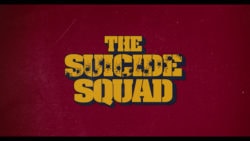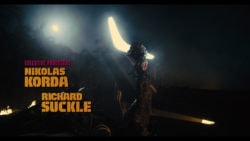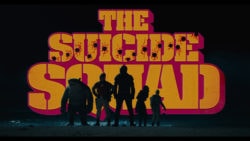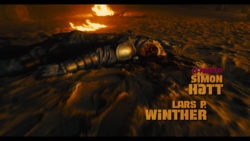CHICAGO – With “The Suicide Squad,” writer/director James Gunn and Warner Bros. Pictures have earned worldwide acclaim for creating what many consider to be the best DC Universe film of all time. For the creatives and producers from one-stop cross-media production company Sarofsky, it was their third James Gunn superhero action adventure, following “Guardians of the Galaxy” and “Guardians of the Galaxy Vol. 2.” Once again, the assignment presented atypical challenges for Sarofsky’s expertise in typography, motion design, blockbuster VFX, and storytelling on a colossal scale.
To set the wheels in motion, together with film editor Fred Raskin ACE (“Once Upon a Time… in Hollywood,” “Guardians of the Galaxy,” “Guardians of the Galaxy Vol. 2,” “The Hateful Eight”), Gunn invited Executive Creative Director Erin Sarofsky and Creative Director Duarte Elvas to screen a cut and discuss the mission. “Our discussion focused on creating titles that were bold, colorful, and worked with the dynamic underlying footage,” Sarofsky began. “We talked about a modern/vintage vibe… something that is very current but also has a nostalgic sensibility.”
“James was clearly looking for treatments that were evocative of 1960s caper war films,” Elvas added. “So, we looked at titling made for films like ‘The Dirty Dozen,’ ‘The Great Escape,’ and ‘The Guns of Navarone,’ and this really informed our exploration.” That initial briefing also identified a few other design opportunities: for the end crawl, subtitles, and to stylistically integrate the WB and DC introductory logos.
Fast forward to the finished film’s opening seconds when viewers see Sarofsky’s stylized logo treatments, the appearance of the distinctive Osprey aircraft, prison walls, and a yellow-and-fuchsia-tinted logo, they are instantly transported into the film’s metaverse.

Further along, the main title sequence commences mid-military-operation as Task Force X (a collection of degenerate DC delinquents, classed-up by Bloodsport, Peacemaker, Harley Quinn, Colonel Rick Flag, Ratcatcher 2, King Shark, and Polka-Dot Man) is invading the enemy-infused island of Corto Maltese. Reflecting “The Suicide Squad” title card’s bold stencil typeface and its highlighted color scheme, title credits begin appearing during phase two of the stealth beach arrival. As the group assembles, the title treatment arises as backdrop, until the oddly upbeat track “People Who Died” by The Jim Carroll Band kicks in, triggering a faster-paced edit. The opening credits play out through that sequence, which grotesquely chronicles the dead and dying, as operatives at mission control callously settle bets based on the rising death toll.
To further illuminate their creative contributions and more details of their latest tryst with Gunn and his “horribly beautiful mind,” Sarofsky, Elvas, and their colleagues revealed a few more key insights CUSTOM TYPE, SPECIAL TREATMENTS, AND MORE.
According to Sarofsky, James Gunn embraces design in his films as another character – which is why typography has been an essential ingredient in their collaborations. This time around, to match the existing logo for The Suicide Squad while also embracing the period war movie vibe, Team Sarofsky dove deep into 1960s films, printed ads, album covers, vintage fonts, and everything else they could find.

“For this job, the best tool we had was our years of typography expertise and our ability to problem solve legibility on a busy background in an intentional way,” Sarofsky explained. “After a few rounds of exploration with the filmmakers, we landed on Alpha Midnight, a 1969 typeface designed by Hiroshi Yamashita, for inspiration. We ultimately modified it so heavily, it could be its own unique font.”
Sarofsky continued, “Addressing the challenge of creating many different elements for the film, it was really important to us to make sure that all the executions related to each other, while also working well for where they were in the film.”
With type set in their custom version of Alpha Midnight for each moment of the main title, for each scene requiring a subtitle, and for the end crawl, Sarofsky’s makers then added more patent artistry to tie into 1960s-era war pictures, visually.
“The steps we took to make the titles appear as though optically printed on actual film were key to making this look like a 1960s film,” Elvas said. “To get them looking just right, each graphic took at least a dozen Adobe After Effects layers, including textures, grain, glows, bevels, and drop shadows. There is also a very subtle gate weave to all the graphics that further emulates the film effect.”

With Adobe Illustrator used for type design and setting, After Effects served the team for look development, layouts, and animation. Sarofsky’s approved end-crawl designs were provided to Scarlet Letters, which set the typography and animated the scroll.
Studio credits for this project also include Executive Producer Steven Anderson, Producer Dylan Ptak, VFX and Finishing Supervisor Cory Davis, and Animator/Designers Josh Smiertka, Cat McCarthy, Andrei D. Popa, Andrea Braga, Tanner Wickware, Jake Allen, and Matt Miltonberger. Final color was courtesy of Company 3.
“Our ability to fit right into the VFX pipeline for major motion picture post-production is an immense source of pride for us here at Sarofsky,” Anderson concluded. “Our well-established workflow allows us to contribute rendered sequences in all the right specs, and thanks to our experienced team, our work not only looks amazing, it integrates seamlessly. That is quite a feat for a such a phenomenal film from one of the world’s foremost filmmakers.”

To learn more about “The Suicide Squad,” please visit https://www.thesuicidesquad.net.
Warner Bros. Pictures Presents An Atlas Entertainment/A Peter Safran Production, A James Gunn Film, “The Suicide Squad.” The film is distributed worldwide by Warner Bros. Pictures.
About Sarofsky
Director, creative director, and designer Erin Sarofsky kick-started Sarofsky in 2009 and formed a group of extraordinarily talented makers who have been providing their services to leaders in the advertising and entertainment industries worldwide. Today, Sarofsky’s makers use animation, visual effects, motion design and live-action to collaborate with customers from concept to delivery, producing work that is visceral, innovative and diverse. With artistry that encapsulates in-house long format, sublime commercials, brand films, title sequences and much more, Sarofsky’s reputation for breakthrough design, its proven multi-media production expertise, and its fabulous Olson Kundig-designed studio in Chicago’s West Loop all constitute key components of the attraction. Learn more at https://www.sarofsky.com.










